Chicago can’t match the number of construction cranes crowding the skylines in high-growth markets such as Nashville, Austin or Atlanta. But now there’s at least one high-profile symbol of growth in downtown Chicago as construction gets under way at 400 Lake Shore, a massive two-tower apartment development.
Developer Related Midwest recently secured more than $500 million in construction financing for the project located on the last vacant waterfront site where the Chicago River meets Lake Michigan. The first phase, already under construction, includes a 72-story building with 635 new apartments, 20 percent (127 units) of which will be affordable.
“The fundamentals in Chicago are strong,” says Mark Stern, managing director at Chicago-based JLL Capital Markets. “Chicago stacks up well compared to other markets in rent growth and occupancy. It’s a great time to be an investor in Chicago.”
Several big, new projects are about to open downtown. Hot neighborhoods such as Fulton Market and the West Loop continue to attract investors and renters. Transit-oriented projects in the suburbs are filling quickly. There’s even some movement to convert empty downtown office space to apartments. And rents are still rising as they flatline or go negative in other markets.
The Chicago area’s multifamily sector does face many of the same pressures as other places. Capital is tight. Transaction volume is down. Affordable housing is scarce and difficult to finance.
The city itself has its own problems. A web of local rules and permitting processes slow new development to a glacial pace. Crime is a deterrent to build in the city. Taxes are high.
Despite the drawbacks, Chicago’s multifamily sector continues to inch forward. “Chicago’s market is historically slow and steady,” says Joe Smazal, senior managing partner at Interra Realty, a Chicago-based commercial real estate investment firm. “We are insulated from big swings.”
Positive Rent Growth
About 10,300 multifamily units in the metro area were delivered over the last 12 months (as of Jan. 29, 2024), according to the CoStar Group, a Washington, D.C.-based real estate data firm. About 11,000 units are under way, roughly a 57 percent drop from the peak year for deliveries reached in 2018.
By comparison, Miami and Phoenix have more than 31,000 units under construction. The only top 20 market with fewer new projects under way than Chicago is Los Angeles, another place with burdensome approval processes.
The big news is that Chicago has positive rent growth. That’s a real plus for landlords and investors at a time when rents in some fast-growing markets have turned negative.
At the end of 2023, year-over-year asking rent growth in the Chicago metro area was 3.1 percent. The national average had gains of only 0.9 percent, according to CoStar.
The Chicago area absorbed about 8,200 units over the last 12 months. The vacancy rate currently stands at 5.7 percent.
“For two consecutive year-ends, Chicago has posted a rent growth rate above the national average,” says Rhea Stephen, senior director of market analytics at CoStar’s Chicago office. “We project that trend to continue into 2024, where Chicago’s asking rents grow roughly by 3 percent year-over-year while the nation lags it by 60 basis points or so.”

Stephen adds that though Chicago gets “dinged” on its population loss, the market still has household growth. The area is still relatively affordable too. The city of Chicago has an estimated population of about 2.6 million, a drop of about 140,000 since the 2020 U.S. Census. The metro area’s population is about 9.6 million.
Rent growth is uneven, however. The urban submarkets posted year-over-year rent growth of 0.9 percent as of mid-January 2024, while the North Side and South Side of Chicago logged 2.2 percent rent growth and the suburban markets’ rents collectively grew by 4.1 percent during this period. DuPage County logged growth of 4.4 percent, according to CoStar.
Research company Yardi Matrix reported an average monthly asking rental rate in Chicago’s urban neighborhoods of $2,193 at the end of 2023; the suburban rate was $1,618.
Best Kept Secret
Demand is strong, according to Mike Zucker, managing partner at Peak Properties, Chicago. The company manages 9,000 units in the metro area. Peak’s properties are 98 percent occupied. Rent increases are in the 3 to 6 percent range.
“Chicago is the best kept secret,” says Zucker. He adds that college graduates are moving to the city for its vibrant lifestyle at an affordable price.
Most of the new development is located in the city’s urban core or on the city’s North Side.
The lively Fulton Market neighborhood, just west of downtown, has three big developments coming online, adding a total of nearly 1,100 units. In the South Loop submarket, the 73-story 1000 M project expects its first move-ins this spring. The project has 738 apartments.
Overbuilding in the city is not a concern, sources say. Chicago has a reputation as a difficult place to build because of an onerous approval process, scaring developers away. In recognition of the problem, Chicago Mayor Brandon Johnson signed an executive order in December 2023 for the 14 city departments involved in project reviews to evaluate current processes and remove bottlenecks.
Notoriously high property taxes, among the highest in the nation, represent another brake on new development and taxes could go higher.
A referendum on the March 2024 primary ballot would increase the transfer tax on city property sales. Properties sold from between $1 million and $1.5 million would pay a transfer tax of 2 percent, nearly triple the current rate. Properties sold for $1.5 million or more would pay a transfer tax of 3 percent, four times the current rate. If passed by voters, the money is earmarked to battle homelessness.
Empty downtown office space — now about 24 percent of the inventory —represents an opportunity for multifamily developers. But no one expects a flood of conversions with the future in question of the city’s LaSalle Street Reimagined Initiative. The program, which Mayor Johnson hasn’t yet taken a stance on, was designed to help finance conversions of an estimated $1 billion worth of projects.
Even so, Corebridge Financial and developer Golub & Co. say they intend to move forward without city subsidies and convert a portion of 30 N. LaSalle Street into 349 apartments. The plans for the 44-story tower still need approval from the city.
Investment Sales Slow
Financing is another big hurdle. Debt capital is available, but rising interest rates and tighter lending criteria make it harder for deals to pencil out.
“It’s a challenging environment,” says Igor Zhizhin, principal at Chicago-based American Street Capital. He says borrowing costs are in the high 6 to 7 percent range. That compares to rates in the high 3 percent range two years ago. Maximum leverage is about 60 percent.
Zhizhin expects the Federal Reserve to cut the federal funds rate—the rate at which commercial banks borrow and lend their excess reserves to each other overnight — by 75 basis points over the course of the year. The current federal funds rate is 5.25 to 5.5 percent. “Lower rates are good for business,” he says. “The real question is how lower rates will impact the sales prices of properties.”
Investment sales volume should pick up in the second half of 2024, says Zhizhin. The south and west sides of Chicago offer opportunities for investors willing to deal with the operational challenges of distressed neighborhoods. Properties there sell for about $50,000 a unit, he says, compared with New York City where nothing sells for less than $200,000 a unit.
Chicago’s 12-month investment sales volume through January 29, 2024, stood at $3.8 billion, down about 32 percent year-over-year, according to CoStar. The biggest deal of the year was the $231 million sale of the 492-unit tower at 727 W. Madison in the West Loop.
A report by Yardi Matrix notes that 40 of the 60 recorded sales involved properties in the renter-by-necessity segment. The average price per unit for these properties was $142,540. Renters by necessity include a range of individuals from young professionals who can’t afford a house to students and blue-collar households.

“There are a lot of headwinds,” says Dan Rosenberg, executive vice president in the Chicago office of BWE, a mortgage banking firm. “Limited partner equity is a challenge for most projects nationally.” He explains that most equity sources are looking for distressed opportunities and signals that the market is at or near a bottom. But sellers are holding out as long as they can until interest rates decline so they can sell their properties at higher prices. “It’s a race against interest rates,” says Rosenberg.
BWE recently financed a new $130 million project at 5400 Old Orchard Road in north suburban Skokie. The development features 245 apartments, 49 rental townhomes and commercial space.
The project is a joint venture between Tucker Development and Wingspan Development. “The capital stack was unique,” says Rosenberg. The construction loan was provided by California-based investment firm Kennedy Wilson. A life insurance company financed the mezzanine loan. The deal included additional layers of capital as well.
“This capital stack would have been a lot simpler a few years ago, and it is a testament to the quality of the sponsorship team and the project that we were able to execute in today’s environment,” notes Rosenberg. He adds that there’s no oversupply of apartments in the north suburban submarket. “It is undersupplied,” he says.
Suburban Downtowns Flourish
Developers are building new projects in suburban downtowns near rail lines. Optima, Inc. recently opened Optima Verdana, a six-story 100-unit rental building in downtown Wilmette, across from the commuter train station in the north suburb.
“The project is on track to stabilize by early this summer, if not earlier,” says David Hovey Jr. president and COO of the company, headquartered in Glencoe, Illinois. Based on the project’s success, Hovey is pursuing a second phase just to the north with 150 apartments.
Amenities are key to attract suburban renters by choice, developers say. Optima Verdana incorporates a number of amenities plus biophilic design, reflected in its landscaped courtyard, rooftop deck plantings, and a unique vertical landscaping system.
“We are optimistic about Chicago’s multifamily market, especially for newer communities that can offer class-defining design, amenities and services in the best locations,” says Hovey.
Other suburban projects are moving forward. Minneapolis-based Opus is focused on transit-oriented projects in suburban downtowns with high barriers to entry. The company is a merchant builder that develops projects that are then sold after stabilization.
In April 2023, Opus delivered a new apartment building in downtown Downers Grove, a suburb west of Chicago. Dash Downers Grove features 167 apartments. The property is 80 percent leased. “It shows there is demand for rental properties,” says Paul Robertson, senior director of real estate development at the Opus office in Rosemont, Ililnois.
The project is attracting older empty nesters as well as young couples and singles. “Home affordability has become an issue for younger people,” says Robertson. The annual median price of a home in the Chicago metro area in 2023 was $324,900, a 4.6 percent increase from the previous year, according to the Chicago Association of Realtors.
Like other suburban projects, Dash Downers Grove includes high-end amenities and a state-of-the-art Wi-Fi network. Residents just scan a QR code to get connected. Appliances and lighting are Wi-Fi-enabled. “The resident response is really positive,” says Robertson. “The Wi-Fi network differentiates the project from others.”
Suburban developers face many of the same challenges as their city counterparts. Good locations are hard to find. Land is difficult to assemble. Municipal approvals take years. Added to that are the uncertainties about valuations.
“It’s hard to underwrite deals because we don’t know what the project will sell for in four years,” says Robertson. “Our capital partners are highly selective. But I’m confident things will get better.”
Rising expenses are another challenge. Wages are higher than they were three years ago. Property and liability insurance is more expensive, and taxes are higher. “Those are the factors that have kept net operating income from growing as fast as rents,” says Robertson.
Looking ahead, multifamily stakeholders think the performance of the Chicago area market will remain steady. They don’t foresee a lot of construction cranes on the horizon anytime soon.
Echoing the consensus view, Gina Fortune-Harmon, vice president of property management at Habitat, says: “The Chicago market was a top performer in 2023 and I anticipate it will continue to hold strong in 2024 based on lack of supply.”
— By Jane Adler. This article originally appeared in the Jan/Feb issue of Midwest Multifamily & Affordable Housing Business.

